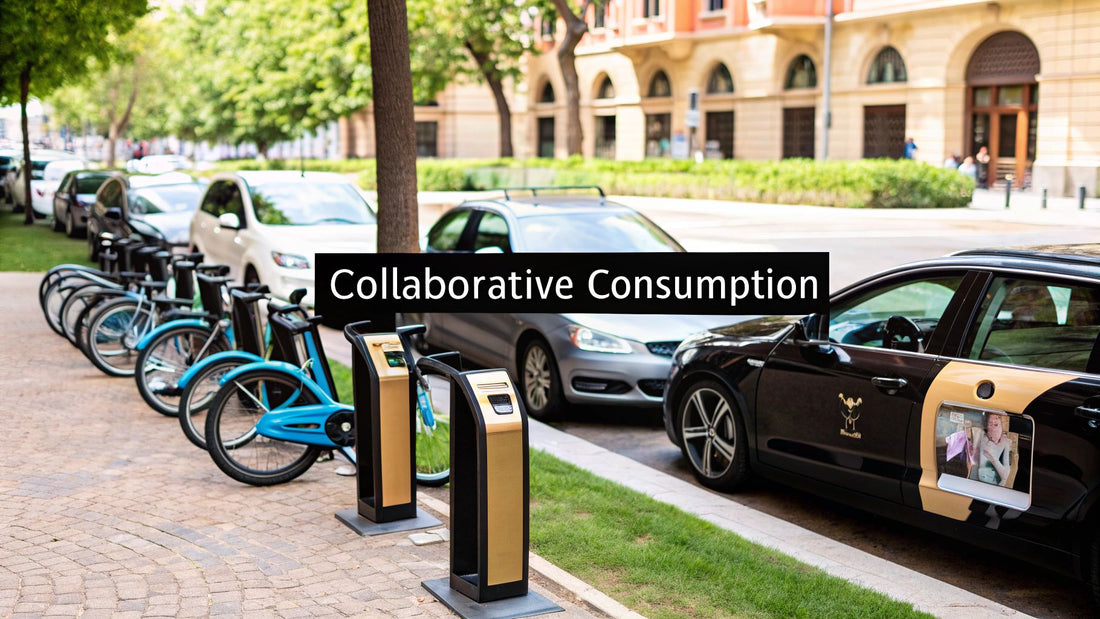
Top Collaborative Consumption Examples You Need to Know
Share
Sharing is Caring: Exploring the Collaborative Consumption Revolution
Want access to premium services, tools, or experiences without the hefty price tag? This listicle explores seven practical collaborative consumption examples, demonstrating how sharing resources benefits both your wallet and the environment. Discover how services like Airbnb and rideshares are part of this growing movement. From co-working spaces and tool libraries to clothing rentals and crowdfunding, you'll find innovative ways to access what you need, affordably and sustainably. Let's dive in.
1. Airbnb
Airbnb stands as a prime example of collaborative consumption, transforming how we think about travel accommodation. It operates as a peer-to-peer marketplace where property owners, acting as hosts, can list their spaces – from spare rooms to entire homes – for short-term rentals. Travelers, in turn, can browse these listings and book accommodations that often offer unique, local experiences and greater affordability compared to traditional hotels. This sharing economy model fosters a more efficient use of existing resources, connecting those with available space to those seeking it. Airbnb’s success lies in its ability to create a mutually beneficial system for both hosts and guests, disrupting the established hospitality industry.

Airbnb's platform boasts a global reach, with listings in over 220 countries and regions. It leverages a robust rating and review system, fostering transparency and trust between hosts and guests. Secure payment processing, along with host and guest verification procedures, are integral to the platform's functionality. Furthermore, Airbnb has expanded its offerings beyond accommodation, venturing into "Experiences" in 2016, connecting travelers with local hosts offering unique activities and tours. This diversification demonstrates the platform's adaptability and commitment to fostering deeper engagement with local communities. Their successful navigation of the COVID-19 pandemic, with a pivot towards rural and domestic travel and the implementation of enhanced cleaning protocols, further underscores their resilience and responsiveness to changing market dynamics. As of 2023, Airbnb boasts over 4 million hosts worldwide, solidifying its position as a leader in the collaborative consumption landscape.
Features and Benefits:
- Peer-to-peer accommodation marketplace: Directly connects hosts and guests.
- Global reach: Offers diverse accommodation options worldwide.
- Rating and review system: Promotes transparency and accountability.
- Secure payment platform: Facilitates safe transactions.
- Host and guest verification: Enhances security and trust.
Pros:
- Income opportunities for property owners: Allows hosts to monetize underutilized space.
- Unique, local experiences for travelers: Offers alternatives to standardized hotels.
- Often more affordable than hotels: Caters to budget-conscious travelers.
- Efficient use of existing resources: Optimizes the utilization of available space.
- Built-in trust mechanisms: Reviews and verifications build confidence.
Cons:
- Regulatory challenges: Faces legal hurdles in certain jurisdictions.
- Impact on local housing markets: Can contribute to rising rents in some areas.
- Inconsistent quality: Standards can vary between properties.
- Potential security and safety concerns: Requires vigilance from both hosts and guests.
- Less professional customer service: May lack the consistent support of traditional hotels.
Tips for Using Airbnb:
- Thoroughly read reviews: Gain insights from previous guests' experiences.
- Communicate clearly with hosts/guests: Establish expectations and address any questions.
- Understand local regulations: Ensure compliance with local laws and regulations.
- Utilize Airbnb's resolution center: Seek assistance with any disputes.
- Consider Superhost properties: Opt for experienced and highly-rated hosts for a more reliable experience.
Airbnb's place on this list is undeniable. It exemplifies collaborative consumption by leveraging technology to connect individuals and resources effectively. It empowers both hosts and guests, fostering a dynamic marketplace that benefits all participants. For travelers seeking unique, often more affordable accommodation options, and for property owners seeking to generate income from their underutilized spaces, Airbnb (www.airbnb.com) offers a compelling solution within the sharing economy.
2. Uber/Lyft Ridesharing
Ridesharing, exemplified by platforms like Uber and Lyft, stands as a prime example of collaborative consumption. It connects drivers using their personal vehicles with passengers seeking transportation, effectively transforming the traditional taxi industry. This model leverages mobile applications for real-time matching of riders and drivers, automated fare calculation based on GPS data, and a cashless payment system, offering efficient transportation solutions in urban and suburban areas. Ridesharing signifies a notable shift from personal car ownership to a transportation-as-a-service approach. It's a perfect example of collaborative consumption because it utilizes existing resources (personal vehicles) to provide a service, reducing the need for individual car ownership and maximizing the utilization of available vehicles.

Ridesharing platforms boast several key features: real-time driver-passenger matching, GPS-based routing and fare calculation, cashless transactions, mutual rating systems for accountability, dynamic pricing based on demand, and multiple service tiers (economy, premium, shared). These features contribute to the convenience and accessibility that have made ridesharing a popular transportation option. The success of this collaborative consumption model is undeniable, with Uber and Lyft operating in numerous cities globally. Their impact extends beyond simple rides, influencing urban planning, traffic management, and even employment models.
Examples of Successful Implementation:
- Uber Eats: Uber's expansion into food delivery leverages its existing driver network for another collaborative consumption service.
- Lyft's Public Transit Integration: In some cities, Lyft integrates with public transit options, showcasing collaboration within the broader transportation ecosystem.
- Enhanced Safety Features: Implementation of features like emergency buttons and ride recording demonstrate a commitment to safety for both drivers and passengers.
- Shared Rides: Options like UberPool and Lyft Line exemplify further collaborative consumption by allowing multiple passengers heading in the same direction to share a ride, reducing costs and environmental impact.
When and Why to Use Ridesharing:
Ridesharing is ideal when you need convenient and on-demand transportation without the costs and responsibilities of car ownership. It's particularly useful in urban environments with good network coverage, offering a potential alternative to driving yourself, especially for short trips, airport transfers, or navigating areas with limited parking.
Pros:
- Convenient, on-demand transportation without car ownership.
- Income opportunities for drivers with flexible hours.
- Often cheaper than traditional taxis.
- Reduces the need for parking in urban areas.
- Potential for reducing drunk driving incidents.
Cons:
- Ongoing regulatory challenges in various jurisdictions.
- Debates surrounding driver classification (employee vs. contractor).
- Safety concerns for both drivers and passengers.
- Surge pricing during peak hours can be expensive.
- Potential contribution to traffic congestion in some cities.
Tips for Using Ridesharing:
- Verify driver and vehicle details before entering.
- Share trip details with trusted contacts for safety.
- Schedule rides in advance for time-sensitive situations.
- Compare prices between different rideshare apps.
- Be mindful of surge pricing during peak times.
Popularized By: Travis Kalanick and Garrett Camp (Uber founders), Logan Green and John Zimmer (Lyft founders), and notable investors including Google Ventures and SoftBank (Uber / Lyft).
Ridesharing's impact on transportation makes it a significant example of collaborative consumption, demonstrating how technology can facilitate the sharing of resources to benefit both providers and consumers. Its widespread adoption highlights its effectiveness in addressing the evolving needs of modern transportation.
3. Bike and Scooter Sharing
Bike and scooter sharing is a prime example of collaborative consumption, offering short-term rentals of these vehicles, primarily in urban environments. These systems leverage mobile app technology, allowing users to locate available bikes or scooters, unlock them via QR code or Bluetooth, and pay for their usage, typically on a per-minute or per-trip basis. This provides a convenient and efficient way to travel short distances, acting as an alternative to private cars or public transport for quick trips across town. This approach contributes to a more sustainable urban transportation model by reducing reliance on individual vehicle ownership.

Bike and scooter sharing systems come in two main forms: docked and dockless. Docked systems require users to pick up and return vehicles to designated stations, while dockless systems offer more flexibility, allowing users to park within designated areas using GPS technology. Both utilize mobile app integration for locating, unlocking, and paying for the vehicles. GPS tracking is also crucial for fleet management, allowing companies to monitor vehicle location and redistribute them as needed. Options range from traditional bicycles to electric-assist bikes and electric scooters, catering to different preferences and distances.
This collaborative consumption model is highly beneficial for both individuals and cities. It reduces carbon emissions by offering an alternative to car usage, helps solve "last mile" transportation challenges by connecting public transit hubs with final destinations, and decreases traffic congestion. It also provides an affordable transportation option, especially for short trips, and promotes physical activity, particularly with bike sharing.
However, there are also challenges. Dockless systems, in particular, can contribute to sidewalk clutter if users don't park responsibly. Vandalism and theft are ongoing concerns, and the service is inherently weather-dependent. Safety, especially with e-scooters, is a crucial issue, requiring careful regulation and user responsibility. Furthermore, these systems are generally limited to urban areas with sufficient population density to be viable.
Successful implementations of bike and scooter sharing can be seen worldwide. Citi Bike in New York City, with its vast network of bikes and stations, is a prominent example. Companies like Lime and Bird have spearheaded the global expansion of dockless systems, operating in hundreds of cities. Municipal programs, such as Vélib' in Paris and Bicing in Barcelona, demonstrate the commitment of local governments to sustainable transportation.
Tips for using bike and scooter sharing services:
- Download multiple apps: This ensures availability, especially in areas with multiple providers.
- Check vehicle condition: Before starting your ride, inspect the brakes, tires, and battery level (for electric vehicles).
- Be aware of local regulations: Know the rules regarding helmet use and where riding is permitted (e.g., streets, bike lanes, sidewalks).
- Park responsibly: Avoid blocking sidewalks or other public access points to avoid fines.
- Look for subscription options: If you're a frequent user, subscriptions can offer significant cost savings.
Bike and scooter sharing deserves its place on this list of collaborative consumption examples because it embodies the core principles of shared access and resource utilization. It provides a practical and sustainable solution to urban transportation challenges, benefiting individuals, communities, and the environment. This model's reliance on technology, user-based pricing, and flexible access makes it an appealing and effective approach to collaborative consumption.
4. Co-working Spaces
Co-working spaces are a prime example of collaborative consumption. They offer shared workspaces for a diverse range of professionals, from remote workers and freelancers to startups and even established companies. Instead of each individual or company bearing the full cost of a private office, co-working spaces pool resources to provide flexible office solutions, ranging from hot desks in an open shared area to dedicated private offices, all while fostering a sense of community. This collaborative approach significantly reduces the overhead costs associated with traditional office leases, making it a more accessible and efficient way to work. Co-working spaces represent a shift from individual ownership to shared access, a core principle of the collaborative consumption model.

Co-working spaces provide various amenities, including meeting rooms, high-speed Wi-Fi, printers, communal kitchens, and often even social events. This offers users access to professional resources and networking opportunities they might not otherwise have. Flexible membership options are a key feature, allowing users to choose from daily passes to permanent desks, providing scalability for businesses and adaptable solutions for individuals. This pay-as-you-go structure aligns with the collaborative consumption ethos, enabling users to only pay for what they need. Learn more about Co-working Spaces
Examples of successful co-working spaces:
- WeWork: A global network of over 700 locations, offering various workspace solutions and a strong emphasis on community building.
- Impact Hub: Focusing on social innovation, Impact Hub provides co-working spaces in over 100 locations, fostering collaboration and positive social impact.
- The Wing: A network of women-focused co-working spaces designed to provide a supportive and empowering environment for female professionals.
- Industry-specific spaces: Niche co-working spaces cater to particular industries, such as Green Desk for eco-focused businesses, offering tailored resources and fostering industry-specific networking.
Tips for choosing a co-working space:
- Try before you buy: Take advantage of day passes or trial memberships to experience the space and its community before committing to a longer-term agreement.
- Location, location, location: Consider the proximity to your clients, home, or other important locations.
- Community matters: Evaluate the community vibe and networking opportunities. A strong community can be a valuable asset for business growth and professional development.
- Amenity check: Ensure the co-working space offers the amenities crucial to your business needs, such as meeting rooms, printing facilities, or specific software.
- Flexibility is key: If you work non-standard hours, look for spaces with 24/7 access.
Pros:
- Reduced overhead: Compared to traditional office leases, co-working spaces significantly lower costs.
- Flexibility: Easily scale your workspace up or down as your needs change.
- Networking: Connect with diverse professionals and potential collaborators.
- Professional image: Access professional meeting spaces for client interactions.
- Work-life balance: Provides a dedicated workspace separate from home for remote workers.
Cons:
- Distractions: The open nature of some co-working spaces can be noisy and distracting.
- Limited privacy: Less privacy than private offices.
- Cost for occasional use: Can be more expensive than coffee shops for infrequent use.
- Availability: Popular locations may have waitlists or limited desk availability.
- Variable quality: Amenities and community atmosphere can vary between spaces.
Co-working spaces deserve a spot on this list of collaborative consumption examples because they perfectly embody the sharing economy principles. They provide a valuable service by pooling resources, reducing individual costs, and fostering a sense of community, offering a more efficient and collaborative way to work in today's dynamic professional landscape.
5. Tool and Equipment Sharing
Tool and equipment sharing is a prime example of collaborative consumption, allowing individuals and businesses to access specialized tools and equipment without the burden of ownership. This approach offers a practical solution to the problem of owning expensive, infrequently used items that take up valuable storage space. Instead of purchasing outright, users can rent precisely what they need, precisely when they need it. This model reduces waste and promotes efficient resource utilization, making it a sustainable and economically savvy choice. This makes tool and equipment sharing a valuable example of collaborative consumption.
This sharing economy sector operates through various models. Formal rental businesses like Home Depot Tool Rental offer a wide selection of construction and landscaping equipment. Alternatively, community-based initiatives like the ToolLibrary programs in cities like Toronto and Portland provide borrowing options for members. Peer-to-peer platforms, such as Fat Llama, represent another approach, enabling individuals to monetize their underutilized tools and equipment, from power drills to cameras and drones. Even established platforms like Turo are expanding beyond car sharing to include specialty and recreational vehicles, further illustrating the growing demand for shared access to equipment. Learn more about Tool and Equipment Sharing
For those interested in participating in the sharing economy from a business perspective, setting up a rental service can be a lucrative venture. Check out this guide on how to start an equipment rental business.
Features of Tool and Equipment Sharing:
- Variety of Access Models: Choose between peer-to-peer lending or centralized rental services.
- Wide Selection: Find everything from basic power tools to highly specialized equipment.
- Protection Options: Many platforms offer insurance and damage protection.
- Reservation Systems: Plan ahead and reserve equipment for specific dates.
- Flexible Rental Periods: Rent items for hours, days, weeks, or even months, depending on your needs.
Pros:
- Cost Savings: Access expensive equipment without the high upfront purchase cost.
- Reduced Storage Needs: No need to store bulky items you rarely use.
- Environmental Benefits: Shared usage reduces overall consumption and waste.
- "Try Before You Buy": Rent equipment to test it before committing to a purchase.
- Income Potential: Monetize your own underutilized tools and equipment.
Cons:
- Risk of Damage: Potential for equipment damage or improper use.
- Availability Issues: Desired equipment may not always be available when needed.
- Variable Quality: Quality and maintenance can vary, particularly in peer-to-peer systems.
- Transportation Logistics: Transporting large or heavy equipment can be challenging.
- Learning Curve: May require a learning curve for unfamiliar tools.
Tips for Successful Tool and Equipment Sharing:
- Inspect Thoroughly: Carefully inspect equipment for any pre-existing damage before accepting it.
- Document Condition: Take photos or videos of the equipment's condition before and after use.
- Consider Delivery: Explore delivery options for large or heavy items.
- Compare Costs: Compare rental costs against the purchase price if you anticipate frequent use.
- Look for Discounts: Check for multi-day or long-term rental discounts.
Tool and equipment sharing exemplifies the power of collaborative consumption by providing affordable access to resources, promoting sustainability, and fostering community engagement. Whether you’re a DIY enthusiast, a small business owner, or simply looking to save money and space, exploring this collaborative consumption model can be a smart and sustainable choice.
6. Clothing Rental Services
Clothing rental services represent a prime example of collaborative consumption, allowing users to access high-quality garments without the commitment and cost of outright ownership. This model promotes the shared use of resources, reducing the environmental impact of fast fashion and offering a cost-effective way to diversify one's wardrobe. Instead of purchasing an item that might only be worn a few times, individuals can rent it, maximizing its utilization and minimizing textile waste. This collaborative approach benefits both the consumer and the environment, making it a compelling option in today's consumption landscape.
These platforms operate by offering a curated selection of clothing, often designer or high-end brands, available for rent for specific periods. Users can typically choose from a subscription-based model, receiving a regular rotation of garments, or a one-time rental for special occasions. Professional cleaning between users ensures hygiene and maintains the quality of the clothing. Some platforms even offer "try-before-you-buy" options, blurring the lines between rental and retail and allowing customers to test out styles before committing to a purchase. Features like these contribute to the growing popularity of clothing rental as a viable alternative to traditional shopping.
Successful implementations of this model are becoming increasingly prevalent. Rent the Runway, a pioneer in the space, expanded from its initial focus on special occasion wear to encompass everyday clothing rentals. Le Tote's acquisition by Lord & Taylor further demonstrates the integration of rental services within traditional retail models. Nuuly, a brand under URBN, offers subscriptions featuring contemporary brands, while Armoire caters specifically to professional women's workwear. These diverse offerings cater to various needs and style preferences, solidifying the place of clothing rentals in the fashion industry.
Pros:
- Access to high-end fashion at reduced costs: Experience luxury brands without the hefty price tag.
- Reduced environmental impact: Contribute to a more sustainable fashion ecosystem.
- Wardrobe variety without accumulation: Enjoy a constantly evolving style without overflowing closets.
- No maintenance or storage concerns: Say goodbye to dry cleaning and storage space limitations.
- Try-before-you-buy options: Make informed purchase decisions.
Cons:
- Potential fit issues without in-person trying: Sizing discrepancies can occur.
- Limited availability of popular items during peak seasons: Advanced planning is essential.
- Cleaning and maintenance concerns for some users: Reliance on the platform's cleaning processes.
- Rental costs can accumulate over time: Strategic purchasing may be more economical for frequently worn items.
- Scheduling challenges for specific events: Last-minute rentals might not always be feasible.
When and why to use this approach:
Clothing rental services are ideal for individuals seeking cost-effective access to premium fashion, those who value sustainability, and anyone looking to experiment with different styles without the commitment of ownership. Whether you need a stunning gown for a special event, want to refresh your work wardrobe, or simply desire a more sustainable approach to fashion, rental services offer a compelling solution.
Actionable Tips:
- Order well in advance, especially for crucial events, allowing time for exchanges.
- Consult sizing guides diligently and read reviews from other users with similar body types.
- Consider subscription services for regular wardrobe refreshes.
- Compare the long-term costs of renting versus buying, particularly for classic pieces you'll wear repeatedly.
- Look for rental services that provide insurance for minor damages.
Learn more about Clothing Rental Services
The rise of clothing rental services has been fueled by figures like Jennifer Hyman and Jenny Fleiss, the founders of Rent the Runway, as well as fashion influencers advocating for sustainable consumption and celebrity endorsements of rental platforms for high-profile events. The growing awareness of the fashion industry's environmental impact has also contributed significantly to the increasing popularity of this collaborative consumption model. This method rightfully earns its place on this list as a practical and environmentally conscious approach to fashion consumption, offering a range of benefits to both individuals and the planet.
7. Peer-to-Peer Lending and Crowdfunding
Peer-to-peer (P2P) lending and crowdfunding represent a prime example of collaborative consumption applied to financial services. Instead of relying on traditional financial institutions like banks, these platforms connect individuals and businesses seeking capital directly with individuals willing to lend or invest. This creates a more direct and often more accessible financial ecosystem. This approach is a powerful example of collaborative consumption because it leverages the collective resources of a community to meet financial needs, bypassing traditional gatekeepers.
How it Works:
P2P lending platforms act as intermediaries, matching borrowers with lenders based on risk profiles, loan amounts, and desired returns. Borrowers apply for loans, specifying the amount and purpose, while lenders browse available investment opportunities and choose where to allocate their funds. Crowdfunding platforms, on the other hand, typically focus on raising capital for specific projects or ventures. Individuals contribute smaller amounts, often in exchange for rewards or equity, collectively funding the overall goal.
Examples of Successful Implementation:
- LendingClub: A pioneer in P2P lending, connecting borrowers with investors for personal loans, auto refinancing, and other financial products.
- Kickstarter: A hugely popular platform for creative projects, allowing creators to raise funds directly from their audience, offering rewards in return for contributions. Kickstarter has helped raise over $7 billion for creative projects since its founding.
- Kiva: Focuses on microloans for entrepreneurs in developing countries, empowering individuals to start or grow small businesses and improve their livelihoods.
- GoFundMe: The dominant platform for personal cause fundraising, enabling individuals to raise money for medical expenses, emergencies, or other personal needs.
Features and Benefits:
- Direct Matching: Cuts out the middleman, allowing for potentially lower interest rates for borrowers and higher returns for lenders.
- Risk-Based Interest Rates: Interest rates are set based on the borrower's creditworthiness, offering higher potential returns for lenders willing to take on more risk.
- Diverse Funding Options: From traditional loans to equity investments, catering to various financial needs and investment strategies.
- Specialized Platforms: Platforms cater to different niches, from small business loans to creative projects.
- Transparency: Funding allocation is often more transparent than in traditional banking, allowing lenders to see exactly where their money is going.
Pros:
- Access to Capital for Underserved Borrowers: Provides funding options for individuals and businesses who might struggle to secure loans from traditional banks.
- Potentially Higher Returns for Lenders: Offers the potential for higher returns compared to traditional savings accounts or other low-risk investments.
- Ability to Support Specific Causes or Entrepreneurs: Allows individuals to directly support causes and projects they believe in.
- More Flexible Terms: In some cases, P2P lending can offer more flexible repayment terms than traditional banks.
Cons:
- Higher Risk of Default: P2P lending and some forms of crowdfunding carry a higher risk of borrower default compared to traditional investments.
- Less Regulatory Protection: These platforms may offer less regulatory protection for investors compared to traditional banking.
- Platform Dependency: Investors and borrowers are reliant on the platform's stability and continued operation.
- Limited Recourse in Case of Default: Recovering funds in case of borrower default can be challenging.
Tips for Using P2P Lending and Crowdfunding:
- Diversify: Spread investments across multiple borrowers to reduce risk.
- Start Small: Begin with small investments to understand the platform and assess your risk tolerance.
- Research: Investigate the platform's history, default rates, and fee structure before committing funds.
- Understand Tax Implications: Be aware of the tax implications of interest earned or returns received.
- Consider Social Impact: Alongside financial returns, consider the social impact of your investments, particularly in platforms like Kiva.
When and Why to Use this Approach:
P2P lending and crowdfunding are excellent options for individuals seeking alternative investment opportunities with potentially higher returns, and for borrowers who may not qualify for traditional loans. They also empower individuals to directly support causes and entrepreneurs they believe in. This approach fits perfectly within the collaborative consumption model, demonstrating how leveraging shared resources can disrupt traditional financial systems. This makes it a deserved entry on our list of collaborative consumption examples.
Collaborative Consumption: 7 Key Examples Compared
| Platform | Implementation Complexity 🔄 | Resource Requirements ⚡ | Expected Outcomes 📊 | Ideal Use Cases 💡 | Key Advantages ⭐ |
|---|---|---|---|---|---|
| Airbnb | Moderate: Platform development and regulation compliance needed | High: Technology, global operations, verification systems | Economic disruption of hospitality, income for hosts, unique lodging | Short-term accommodation, local experiences | Large user base, trust system, income opportunities |
| Uber/Lyft Ridesharing | High: Real-time matching, GPS, dynamic pricing | High: Mobile apps, driver coordination, safety features | Transportation convenience, reduced car ownership, flexible income | Urban transportation, on-demand rides | Convenience, flexible driver work, multiple service levels |
| Bike and Scooter Sharing | Moderate: GPS tracking, app integration | Moderate: Fleet management, vehicle maintenance | Reduced emissions, urban last-mile transport, congestion relief | Short urban trips, eco-friendly transport | Environmentally friendly, affordable, promotes health |
| Co-working Spaces | Moderate: Facility management, community building | High: Physical spaces, amenities, events | Flexible workspace, reduced overhead, networking opportunities | Remote work, startups, freelancers | Cost-effective office, networking, flexible terms |
| Tool and Equipment Sharing | Moderate: Reservation, insurance systems | Moderate: Equipment maintenance, logistics | Access to costly tools, reduced storage, sustainability | Occasional tool use, project-based rentals | Cost savings, environmental benefits, income from assets |
| Clothing Rental Services | Moderate: Inventory management, cleaning | Moderate: Logistics, cleaning services | Fashion variety, sustainability, cost savings | Special occasions, sustainable fashion use | Access to designer clothes, reduces waste, flexible wardrobe |
| Peer-to-Peer Lending & Crowdfunding | High: Risk management, platform trustworthiness | Moderate: Platform security, vetting borrowers | Access to capital, alternative investments, social impact | Small business funding, creative projects, microloans | Capital access, transparency, community support |
The Future of Sharing: Collaborative Consumption's Continued Impact
From finding a ride across town to securing a workspace for the day, the collaborative consumption examples explored in this article – including services like Airbnb, Uber/Lyft, bike sharing, co-working spaces, equipment rentals, clothing rental, and peer-to-peer lending – reveal a powerful shift in how we access and utilize resources. The key takeaway is this: sharing isn't just about saving money; it's about maximizing value, minimizing waste, and fostering a sense of community. By embracing these principles, individuals, families, and businesses alike can unlock new opportunities for affordability, sustainability, and connection. Mastering these approaches allows you to optimize your spending, access premium services, and contribute to a more sustainable future.
The collaborative economy isn't a fleeting trend; it's a fundamental shift in consumer behavior, driven by a desire for smarter, more sustainable solutions. As technology continues to evolve, we can expect even more innovative applications of collaborative consumption to emerge, transforming industries and redefining how we interact with the world around us.
Ready to take your collaborative consumption journey to the next level? Explore the possibilities of shared access with AccountShare, a platform that simplifies group purchasing for premium services, offering a practical and affordable way to experience the benefits of collaborative consumption. Visit AccountShare today and discover how you can unlock premium services through the power of shared access.
